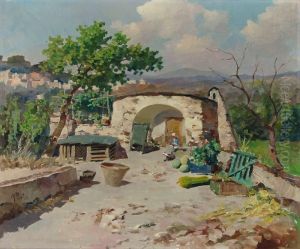Giovacchino Fortini Paintings
Giovacchino Fortini was an Italian sculptor, architect, and writer who played a significant role in the development of Baroque art in Florence during the late 17th and early 18th centuries. Born in 1670 in Florence, Fortini was part of the rich cultural milieu of the city, which was a hub for artists and intellectuals during that time.
Fortini's artistic journey began under the tutelage of prominent Florentine sculptors of his era. He was deeply influenced by the Baroque movement, which was characterized by dramatic expression, rich ornamentation, and dynamic forms. Fortini's work as a sculptor is noted for its emotional intensity and technical virtuosity, qualities that were highly prized in Baroque art.
Throughout his career, Fortini received numerous commissions for religious and secular works, including sculptures, monuments, and architectural projects. His sculptures often featured intricate details and a robust sense of movement, which were hallmarks of the Baroque style. Fortini was also involved in the design and construction of several architectural works in Florence, showcasing his versatility as an artist.
One of Fortini's most notable architectural contributions was his work on the complex of San Firenze in Florence. He also created various sculptures for churches and public spaces, which have been celebrated for their expressive qualities and craftsmanship. Fortini's ability to blend sculpture and architecture in a harmonious manner made him a sought-after artist in his time.
Despite his success, Fortini did not leave behind as extensive a body of written work as some of his contemporaries. However, his artistic achievements were well-documented by art historians of later generations, who recognized his contributions to the Florentine Baroque style.
Giovacchino Fortini passed away in 1739, leaving behind a legacy of work that continued to influence artists and sculptors in Italy and beyond. His dedication to his craft and his ability to capture the spirit of the Baroque era have ensured his place in the history of Italian art.

